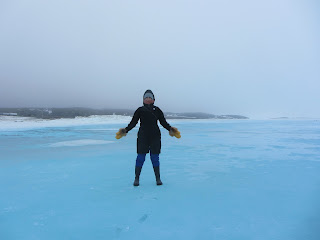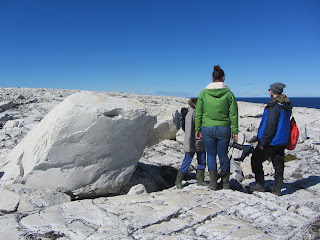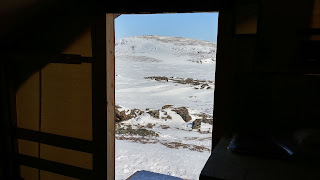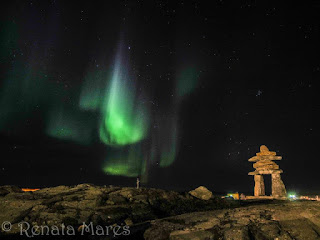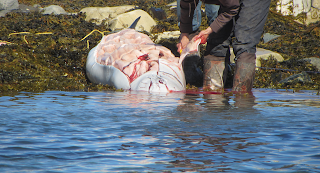(To view the images larger, just click on the photo)
First year in Nunavut was spent exploring 3 communities. Rankin Inlet was my home from May 27 till the end of September 2015. During my time in the Kivalliq region, I had the opportunity to visit Arviat, a community south of Rankin. While it was a very short introduction to both of these places, they have become my reference point to the center region of Nunavut.
However, come October 2015, it was time to re-locate to the City of Iqaluit, which by now, I consider my Arctic home (as I'm writing this entry on Oct 16, 2016). I have spent the last year discovering every corner of this magical city. It makes my heart swell when I think back to all the amazing experiences and places I had the chance to visit during my very short time here. I can only thank the wonderful people, both transient and local, who opened their homes to welcome me, as well, teach me everything I now know about the tundra and Arctic waters. But of course, Mother Nature's lessons are infinite and I have much more learning to do still. Living in the Kivalliq and Qikiqtaaluk region has been so captivating that I find myself wanting to always learn more.
I have become an Arctic nomad, very different from my previous life as an urban explorer. To enjoy the sights and all that the North has to offer, one has to get very familiar with safety and preparations prior to going on the land and water. I am so proud to have learned 'some' of these skills which give me the freedom to roam nature safely. I have yet to learn to use a gun (for safety against unexpected encounters with wild animals) but I figure, I'll always have a friend with me who does :)
These photos may not do total justice in describing my experiences above the 60th parallel however, I hope you still enjoy the views ( #sightsofthenorth ) as much as I have thus far. To me, the Arctic remains a breathtaking place and I have a hard time imagining life without it.
PS: To each and every person - who has contributed to/shared this gift of adventures in the North -THANK YOU for a gift I may never re-pay but I will make it my priority to share with others.
PPS: Part 1 might be the longest post I have ever created however, I have a feeling the other 4 parts will be much simpler to explain. Though I make no such promise since the Arctic is filled with limitless adventures which ignite all of the senses, so brace yourselves.
Cheers
R :)
Overview of the Kivalliq and Qikiqtaaluk landscape
I am not floating in air, rather hiking on the northwest corner of Hudson Bay in May 2015. The colour of the frozen water was very similar to the Caribbean waters however, we were walking on top of it. A very strange sight and feeling to experience. Hiking the tundra for the first time was also a very new experience. The tundra feels very soft and fluffy under your feet. The very first time you walk on ice and tundra becomes an immediate sensory overload. But it also grabs you, and such sensation easily turns to an almost addiction, so much so, that I have been on the land nearly every weekend since arriving to the North.
Riding ATVs (or Hondas, as they are called in Nunavut, regardless of the make) becomes an entirely different sensory overload. The cute little 4-wheeler 'crotch rocket' takes you to places many hours outside of town. The views by Honda are breathtaking and amplified by, I would say, 10 times. During my first Honda ride, I was extremely nervous. I was so tense that my body ached everywhere a few days after. However, seeing the tundra as far as the eye can see, combined with the ride, is a completely different form of a high. It yet again, grabs your soul, the feeling of freedom across this infinite space, is very complicated to explain. One just has to get back on that machine each and every weekend and find new places to explore, that's it.
Rankin Inlet Honda Club - a group of individuals (equally excited about exploring the land) roaming the tundra all summer long, finding new places to camp out - safely - making sure if bears were to come for a visit, we can hear them knock over our helmets, tide to the Hondas.
Check out the view - as far as the eye can see. It does confuse the brain on depth perception. Objects or landmarks seem much closer even though they are probably very far away.
Arctic Waters: visiting Marble Island
Marble island is about 2 hours out, by boat from Rankin. On a sunny day, sitting in a boat for over 4 hours is actually quite fun. Especially, when you get to hike on white marble and unexpectedly end up chasing belugas along the way. Hunting trumps all other boating activities. When you see a sea mammal, tourism takes a back seat, and catching dinner takes priority.
The white marble, in the sun, becomes blinding. It is very hard to look at the landscape without squinting, even through sunglasses. Never seen anything like this before, and I'm not sure if I will have another chance. Just stunning. The snow white rocks combined with the sapphire blue sky and deep blue arctic waters. When I see these photos, it takes me right back to the sights and sounds of this stunning place.
Introducing Arviat
Below Rankin Inlet, on the west edge of the Hudson Bay, lies a little place called Arviat. I have heard stories about this place from a friend's mom. She lived in Arviat during the 1980s when she was starting out her teaching career. The stories she told were of very cold days, walking to and from the school, as well, very limited access to running water at that time. Honey buckets were in regular use. The children found these bags of human waste an entertainment, where they would jump and bounce on the bags till they explode, and watch the human waste flow down the gutters. This might not sound like the most appropriate recreational activity for children however, these stories made me giggle every time.
Today, Arviat looks much different from the stories I was told however, the landscape remained very much the same over the years. Much like Rankin, Arviat is very flat, with the community situated directly next to the waters. It is a very picturesque kind of place. Because of the proximity to the waters, hunting becomes very accessible, and for this same reason, it is a favourite visiting place for polar bears. During my short visit I saw no bears only the large barrels set out to trap them.
Introducing the City of Iqaluit
Where to begin? Since this entry focuses on the sights of all the places I have visited in the North, I must try and capture the same of Iqaluit. However, I find myself getting lost in my list. Since Feb 2016, I have explored Iqaluit and surrounding areas by: 1. walking/hiking 2. cross-country ski 3. snowmobile 4. dog sledding 5. honda 6. staying in a cabin and 7. staying in tents. All these modes of exploration has given me so many different angles and views to this magical place.
Map of Iqaluit Adventures 2016
1. Walking/hiking gives you a gradual bird's eye view from any of the rolling hills in and around the city. The climb up gives the feeling that the houses turn into toy replicas while the hike down brings you back to reality and into feeling small again.
I find the opposite happens when I'm hiking on the tundra. The farther I walk from the city and the more isolated I feel, the space around me becomes infinite. And this same feeling of infinite space makes you feel so very small in the place you stand. Very different from standing on a hill inside the the city, for me at least.
2. Cross-country skiing is very new for me. Actually, I never really learned to ski before I arrived to Iqaluit. No one really believed me until I had to ski down a very tiny elevation on a trail. I basically ignored all my feelings of terror and complete fear of heights in order to explore the views outside the city. The only way to feed my addiction to the tundra was through cross-country ski, and to do that, I had to learn quick and ski often. Nearly every weekend. The result, well, stunning landscapes.
3. Adventures by snowmobile
Now that I have had the chance to try out both hondas and snowmobiles, I might be favouring the snow machines. They crawl low to the ground, and while they can flip easily, there is less bounce to the whole flipping process if it were to happen. I find hondas are much more difficult to steer on the uneven surface of the tundra and scary to drive down a hill. But again, this is my experience. Snow machines tend to be a little more pricier but if you are lucky to find gently used ones, then they would price at a similar range.
With my new found love for snow machines, my hope is to visit Kimmirut and maybe another community by snowmobile in 2017 however, such plans are limited by weather, off-time from work, finding a team to go with, and again weather! Anyone interested out there ???? :)
4. An outing via dog sled thanks to Sarah Mcnair-Landry and her most beautiful pups.
You can read more about Sarah here: Sarah Mcnair-Landry
5. By Honda - and to be more specific, it is a 2008 Yamaha 400 which I'm borrowing for the summer. It is called Bluey, because all best friends deserve a name. Adventures with Bluey involved attending multiple campfires on week days and weekends, camping, hiking, fishing, building a sauna (details of this will be described in a later post), to ultimate frisbee 3x per week, and generally driving around Iqaluit and till the road ends in all directions. Bluey was unable to take me off road but to be honest, I was happy to keep our adventures as safe as possible.
6. By boat
7. From a Cabin
Only the first cabin we used to stay overnight. The other 2 were more like a pit stop, just to take a break and take in the view. Most cabins are easy to open and are there to provide shelter if the weather were to turn dangerous during a hike/travel. However, some cabins are closed off and for private use only.
Regardless, I'm very impressed with the accessibility of cabins everywhere, maintained by their owners, and welcomes anyone who needs a place to warm up. During a snow storm, it is an unforgiving terrain the Arctic tundra and a cabin just might be a life saver, literally.
8. Camping
While Arctic camping during the winter months is very popular among the dog sledding teams and snowmobile enthusiast. However, I have mostly stuck to Arctic camping during the summer months ...mostly for comfort purposes. I am unsure, and not very trustworthy that my joints would cooperate in minus temperatures however, I can still count on them even if the temps are just above zero. Though I must say, during boating and clam digging, my body was stiff by 9pm which means I miss out on the bonfire fun!
Of course, camping is only complete if it involves all-day-long hikes. Luckily I was able to find some great company for both weekends. The views are hard to capture, and they never turn out the same as the 'real deal' via photos. But I remain persistent and keep trying to capture these breathtaking places. I mostly take these pictures for nostalgic purposes, as I revisit each image it takes me back to those same feelings I had when standing smack in the middle of the landscape.
May, 2016
Aug 2016
Fun Fact: Day time vs night time
The shortest day is December 21 (winter solstice) with 4:19 hours of daylight; the longest day is June 20 (a day before summer solstice) with 20:49 hours of daylight.
Summer solstice - each day gets longer by 8 minutes
Winter solstice - 8 min lighter each day
Rankin Inlet Daylight Hours
Source: https://weatherspark.com/averages/28358/Rankin-Inlet-Nunavut-Canada
Iqaluit Daylight Hours
Source: https://weatherspark.com/averages/28242/Iqaluit-Nunavut-Canada
Arctic Skies - Rankin Inlet
Blood moon - Sept 2015
Arctic Skies - City of Iqaluit
Capturing my very first sun dogs
Driving on the sea ice
360 degree sun dog
Toonik Tyme 2016
Kivalliq and Qikiqtaaluk Flora
Kivalliq and Qikiqtaaluk Fauna
Rankin Inlet
snow bunting (I think)
Sik sik
Tuktu (Caribou)
Snow geese egg (?)
crab skeleton
Nanuk (polar bear remains)
Tuktu migrating !!!
most stunning in my experience
Mozies (mosquitoes)
as many mozies as tuktu
Tuktu migrating
sik sik fattening up for the winter
cranes (?)
beluga whale
beluga whale
red fox
vultures
snow geese
vulture
Iqaluit
Welcome to the City of Iqaluit
nanuk skull
arctic char
clams
Views of Inuit Art
Rankin
Arviat colours
Kamiks from Taloyoak
Lithograph from Cape Dorset by Pitaloosie Saila
Sedna wall hanging by Helen Iguptak
In Nunaversary: Part 2 - I aim to capture the smells and fragrance of the North! It is mostly refreshing, and then there's the dump :)
Cheers
Renata :)
